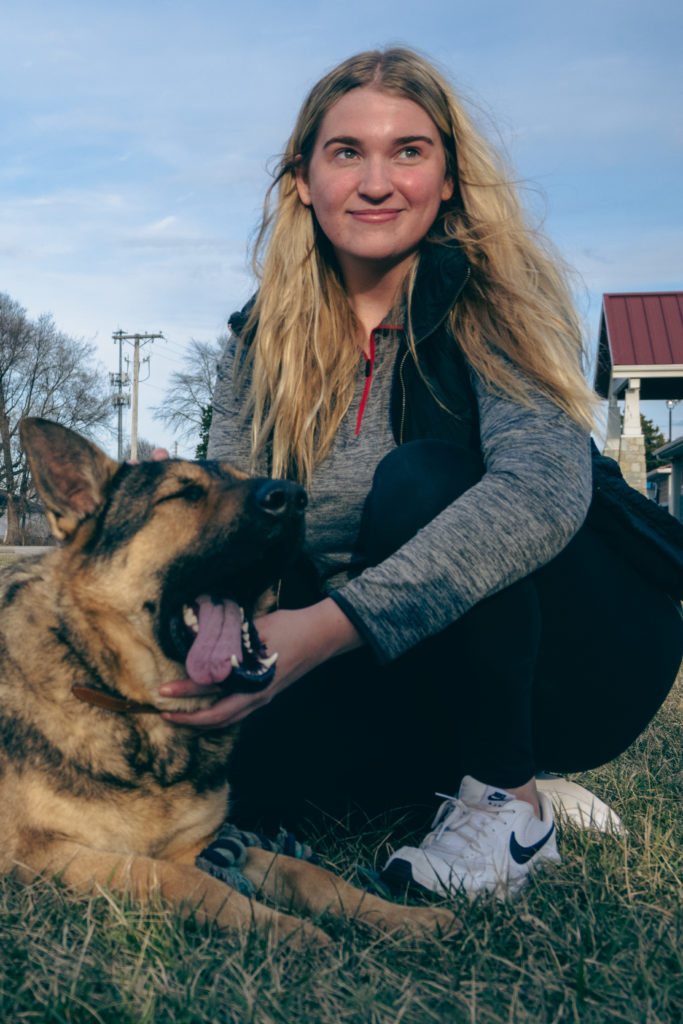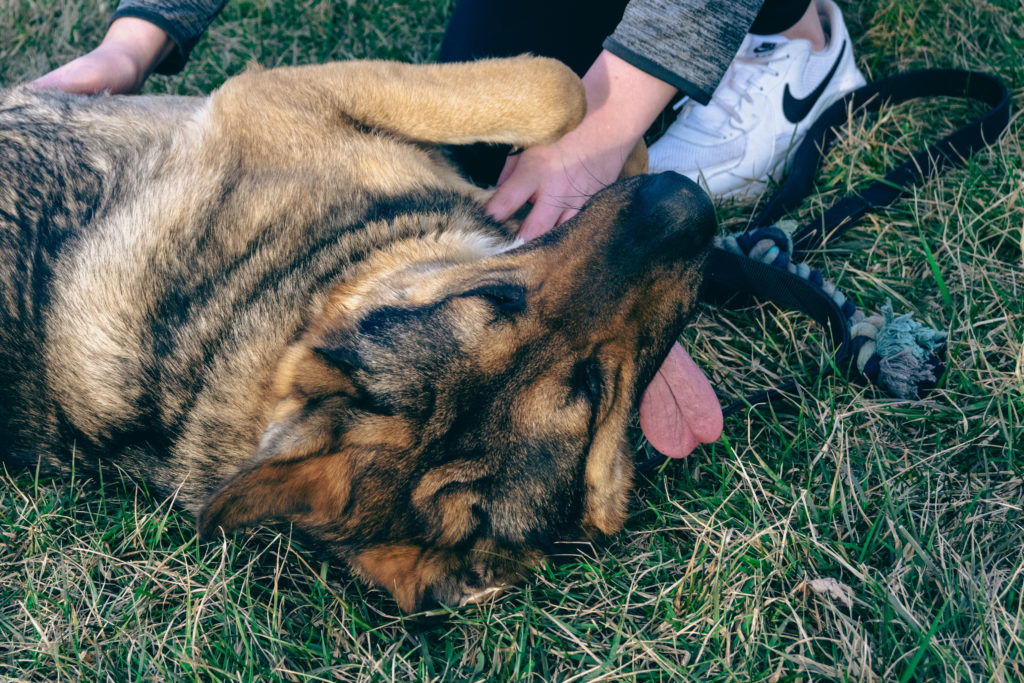“Never take your dog or your cat for granted.”
That’s what Adriana Kublnick, a Muncie resident said after she lost her 3-year-old German Shepherd, Kaizer, last year. For a month, Adriana experienced how her life would be without Kaizer.
Adriana and her family out in the cornfields with 25 acres of land, she explains how Kaizer would like to roam around the field but always returned shortly after. Kaizer was microchipped and had a security tag on, so she and her family expected Kaizer to return.
One night she and her family went out, and when they returned, Kaizer was gone. They took action quickly to try to retrieve Kaizer.
“We didn’t find him that night, so we put stuff on Facebook… since we live out in the cornfields, we would drive out every night anytime we could look for him and didn’t end up finding him,” Adriana says.
The Kublnick family went to shelter after shelter, made phone calls, posted flyers and more.
“We went to all the vets around us. Basically we looked all over Indiana like we drove to the shelters even all the way to Anderson and couldn’t find him there, he’s chipped but nothing came up,” Adriana says. “We put out [a post on] all of the missing pets websites, we put out flyers, we put out signs all over the roads, up in the gas stations and still didn’t hear anything.”
With the different steps Adriana’s family took, they noticed one received more attention — social media.
“Our Facebook posts actually went pretty viral; it got 1,500 shares… so everyone knew about it, everyone was trying to help in finding him,” Kublick says.
Many shares and comments on the Facebook post drove traffic for people in the community to “stay aware” of where Kaizer might be.
Adriana shared how she kept losing hope when people claimed to have found the dog, but it turned out to be another dog that looked similar to Kaizer.

Roxie Randall, manager of Community Outreach Animal Care Services in Indianapolis, says that many animals go missing daily, but more often it happens during major holidays such as Christmas, New Years, or Thanksgiving.
Randall shared advice for current pet owners to try to prevent their furry animals from going missing.
“Checking fences and gates for gaps are easy ways to get out, training your pet not to dart out of the door. If having a large gathering, it is best to have the pet confined to a spare room or to their crate,” Randall says. “Train family living in the home to ensure that all doors are fully closed at all times… Ensuring the security of windows as well.”
Even after following all the steps on making sure your pet is secure, your pet may still get lost. According to Randall, there are various steps that can be taken to try and find your pet in this instance.
Randall shared the first step is posting on social media, there are many pages to post on such as missing animal sites or neighborhood groups. Second, if your pet is microchipped, contact the microchipping company to mark them as missing and make sure the contact information on the microchip is up to date.
The third step would be to check local shelters or rescues and hang fliers.
“The pet owner can also get the small yard signs made to help alert neighbors to their missing pet in case they have spotted it,” Randall says.
Randall encourages pet owners to look into microchipping, describing it as “incredibly effective.”
“The return to owner rate for a microchipped pet is significantly higher than one that is not. The AVMA conducted a study of over 7,000 animals and it showed that microchipped dogs are over twice as likely to be reunited with their families than those that did not have a microchip,” Randall says.
Being on the lookout for animals in the community can help keep everyone safe and bring families together, Randall says.
“It is also important because sometimes lost pets can become a nuisance to neighborhoods,” she says.
The key is to be on the lookout for animals missing from their families. Randall said people who may encounter a lost pet should start with the basics.
“Take the pet to the clinic or shelter to get scanned for a microchip; many of these will have sections for ‘found pets,’” Randall says.
After a couple weeks full of false hope, Adriana was certain she would never see Kaizer again. Once Adriana’s father raised the reward to $150 on finding the German Shepherd, two people quickly reached out saying they found Kaizer. The people that had Kaizer said “they didn’t know he was lost.”
“My dad went to meet the people at the gas station and pick [Kaizer] up and bring him home, and I just sat there and bawled, and he was so happy to be home,” Adriana says.
Adriana shared how she was filled with emotions. She was relieved to find her dog, but angry knowing someone had Kaizer during that time.
Once Kaizer returned home, Adriana and her family noticed a few changes in Kaizer’s behavior. Adriana explains how Kaizer will have a “guard up” with unfamiliar surroundings.
“He turned aggressive, and he was never aggressive,” Adriana says, “He’s not super aggressive, but towards strangers now he’s scared,” Adriana says.

Kaizer’s family now takes extra precaution to make sure he doesn’t get lost again: using a Ring doorbell to watch him.
Sharron Sharkitt, Muncie resident and president for Action for Animals also has her “miracle story” in relation to losing a pet.
Sharron first started as a volunteer for Action for Animals 25 years ago. Back in 2002, people in her neighborhood knew her as someone that rescued kittens. One evening Sharron found a tomcat in her yard. The cat appeared to have some hygiene concerns and needed some care.
Without hesitation Sharron took this cat in and gave him treatment and had him neutered. The cat had some characteristics that made him stand out compared to the other cats she had. The cat had stripes down the front that helped identify him.
In 2014, the cat, Karma, didn’t return home. Sharron explained that the cat was an indoor and outdoor cat but would always return daily. When Karma didn’t return, Sharron figured he could have gotten lost or someone might have picked him up.
After two years of not having Karma, Sharron was working as a postmaster in New Castle for Henry County. She had the job of transporting kittens back and forth from shelters, such as the Humane Society in Newcastle.
One evening, Sharron received a cat at the shelter. When she was looking at all of the cats, she noticed one cat poke his paw out of the cage. The cat looked familiar. And suddenly it all clicked.
“He got lost a long time ago but it [looked] just like him and he was in pretty rough shape,” Sharron says. “I looked and said ‘I’m fairly sure this is my cat,’ so I went home and got pictures and it turned out it was him.”
After looking at photos and having Karma back home, Sharron had more confirmation that this was her cat she had lost in previous years.
Now Sharron continues helping stray cats around Muncie through Action for Animals.
Sharron and Adriana both shared the similar experience of knowing the feeling of missing animals. Adriana wanted to share some advice for pet owners that might be looking for their lost pet.
“Never stop looking, even when you think you’re never gonna find them, ” Adriana says.




